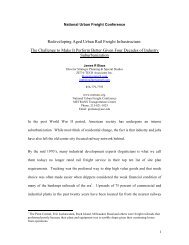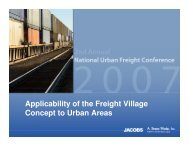Table of Tables - METRANS Transportation Center
Table of Tables - METRANS Transportation Center
Table of Tables - METRANS Transportation Center
Create successful ePaper yourself
Turn your PDF publications into a flip-book with our unique Google optimized e-Paper software.
Evaluating the Feasibility <strong>of</strong> Electrified Rail at the<br />
Port <strong>of</strong> LA/LB<br />
Abstract<br />
Electrifying r ail at t he P orts <strong>of</strong> Los Angeles and Long Beach has t he potential to both<br />
replace t he c ongestion a nd pol lution <strong>of</strong> dr ayage trucks, a nd t he pol lution <strong>of</strong> r ail. T he<br />
electrification process was analyzed in light <strong>of</strong> costs, utility, and safety. The length <strong>of</strong><br />
rail considered for replacing drayage trucks is about 12 miles at the Ports <strong>of</strong> LA and LB<br />
to connect terminal clusters to the UP ICTF, and an additional 20 miles <strong>of</strong> a single line<br />
along the Alameda corridor to the BNSF Hobart yard; assuming the SCIG is not built.<br />
Cost <strong>of</strong> retr<strong>of</strong>itting conventional rail with at-ground third rail is from $1.42M to $1.5M<br />
per mile verses $.825M to $1.5M per mile for overhead caternary; excluding the costs <strong>of</strong><br />
new or r etr<strong>of</strong>it loc omotives—from $2M t o $5M e ach, a nd a dditional e lectric pow er<br />
distribution requirements for more tractive power. Operational decisions by the class one<br />
rails regarding “switch out” to Diesel power for transcontinental runs will determine the<br />
number <strong>of</strong> ne w or m odified l ocomotives r equired; a nd t he l ength ( weight) <strong>of</strong> s huttle<br />
trains w ill de termine the pow er di stribution c osts. Neither at -grade t hird r ail nor<br />
overhead c aternary a re c onducive t o t rain f ormation i nvolving l oading, unl oading, a nd<br />
numerous short switched sidings. H owever, operational requirements such a switching<br />
and pow er r equirements f avor ove rhead c aternary, m aking i t t he b etter a pproach for<br />
hauling train sections or shuttle trains from the port to Diesel pulled transcontinental train<br />
Intermodal. Safety requirements also infer overhead lines are the better way for retr<strong>of</strong>it<br />
electrification.<br />
iii




